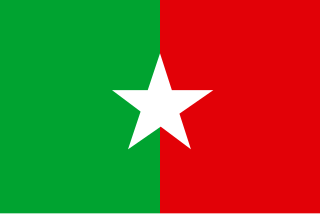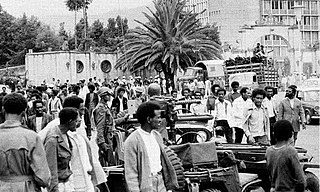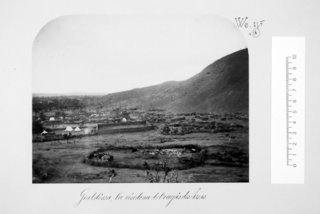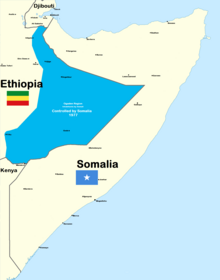
The Somali Democratic Republic (Somali: Jamhuuriyadda Dimuqraadiya Soomaaliyeed; Arabic: الجمهورية الديمقراطية الصومالية, al-Jumhūrīyah ad-Dīmuqrāṭīyah aṣ-Ṣūmālīyah; was the name of the socialist totalitarian military government dictatorship given to Somalia under President Major General Mohamed Siad Barre, after seizing power in a coup d'état on 21 October 1969. The coup came a few days after a bodyguard assassinated Abdirashid Shermarke, the nation's second President. Barre's administration ruled Somalia for the next 21 years until Somalia collapsed into civil war in 1991.

The Western Somali Liberation Front was an Ogaden separatist group fighting in eastern Ethiopia to liberate the Ogaden region from Ethiopian control. It played a major role in the Ogaden War of 1977–78, assisting the invading Somali Army.

Dire Dawa is a city in eastern Ethiopia near the Oromia and Somali Region border and one of two chartered cities in Ethiopia. Dire Dawa alongside present-day Sitti Zone were a part of the Dire Dawa autonomous region stipulated in the 1987 Ethiopian Constitution until 1993 when it was split by the federal government into a separately administered chartered city.

Jijiga is the capital city of Somali Region, Ethiopia. It became the capital of the Somali Region in 1995 after it was moved from Gode. Located in the Fafan Zone with 70 km (37 mi) west of the border with Somalia, the city has an elevation of 1,634 metres above sea level. Jigjiga is traditionally the seat of the Bartire Garad Wiil-Waal of the Jidwaaq Absame. The International airport is named after him.

The Ogaden War, also known as the Ethio-Somali War, was a military conflict fought between Somalia and Ethiopia from July 1977 to March 1978 over the sovereignty of Ogaden. Somalia's invasion of the region, precursor to the wider war, met with the Soviet Union's disapproval, leading the superpower to end its support for Somalia to fully support Ethiopia instead.

The Somali National Army is the ground forces component of the Somali Armed Forces, and is the largest out of the three service branches that make up the majority of the Armed Forces.

The Ethiopian Civil War was a civil war in Ethiopia and present-day Eritrea, fought between the Ethiopian military junta known as the Derg and Ethiopian-Eritrean anti-government rebels from 12 September 1974 to 28 May 1991.

The Ethiopian–Somali conflict is a territorial and political dispute between Ethiopia, Somalia, and insurgents in the area, Originating in the 1300s, the conflict's most recent iteration began in the late 1940s when the Somali-inhabited Ogaden region was handed back to Ethiopia by the British. In the years following, tensions culminated in numerous insurgencies and several wars. However, because of the Somali Civil War and the lack of a functioning central government since the collapse of the Democratic Republic of Somalia in 1991, Ethiopia has the upper hand militarily and economically.
Degehabur is a town in the Somali Region of Ethiopia. It is located in the Jarar Zone of the Somali Region. Degahabur is occupied by the Rer Isaaq ,Ogaden. Degehabur sits at 1044 meters above sea level. The town is the administrative center of Degehabur woreda.

The Somaliland Campaign, also called the Anglo-Somali War or the Dervish War, was a series of military expeditions that took place between 1900 and 1920 in modern-day Somalia. The British were assisted in their offensives by the Ethiopian Empire and the Kingdom of Italy.
The 1982 Ethiopian–Somali Border War occurred between June and August 1982 when Ethiopia, sending a 10,000 man invasion force backed by warplanes and armored units, supported by thousands of SSDF rebels invaded Central Somalia. The United States government responded by speeding up deliveries of light arms and main battle tanks already promised. In addition, the initially pledged US$45 million in economic and military aid was increased to US$80 million.
The Battle of the Ogaden was fought in 1936 in the southern front of the Second Italo-Abyssinian War. The battle consisted of attacks by the Italian forces of General Rodolfo Graziani, the commander-in-chief of the forces on the "southern front", against Ethiopian defensive positions commanded by Ras Nasibu Emmanual. The strong defensive positions were designed by Wehib Pasha and known as the "Hindenburg Wall". The battle was primarily fought to the south of Harar and Jijiga.
Chinaksen is a town located in Chinaksen woreda, East Hararghe Zone of the eastern Oromia Region, Ethiopia. This city has a latitude and longitude of 9°30′N42°42′E with an elevation of 1816 meters above sea level. Chinaksan is a historical settlement with stone walls built at the foot of an oval hill; on the hill are ruins of fortifications of Adalite origins during the Adal Sultanate period.

Jaldessa is a village in eastern Ethiopia. Located in the Shinile Zone of the Somali Region of Ethiopia.

The military history of Somalia encompasses the major conventional wars, conflicts and skirmishes involving the historic empires, kingdoms and sultanates in the territory of present-day Somalia, through to modern times. It also covers the martial traditions, military architecture and hardware employed by Somali armies and their opponents.
Chiro (also called Carcar ciroo in Oromo is a town and Aanaa in eastern Ethiopia. Located in the West Hararghe Zone in Oromia Regional State, Ethiopia Ahmar Mountains, it has a latitude and longitude of 9°05′N40°52′E and an altitude of 1826 meters above sea level. It is the administrative center of the West Hararghe Zone in Oromia Regional State.
The military history of Djibouti encompasses the major conflicts involving the historic empires and sultanates in the territory of present-day Djibouti, through to modern times. It also covers the martial traditions and hardware employed by Djiboutian armies and their opponents.
The Battle of Harar was a battle of the Ogaden War. The battle took place from October 1977 until January 1978, and was fought near Harar, Ethiopia. The Cuban soldiers took part supporting the Ethiopian army, during the battle they engaged the attackers in vicious fighting.

The Battle of Dire Dawa were a series of battles that took place since 17 July to 17 August 1977 between Ethiopian Armed Forces and Somali Armed Forces near the town of Dire Dawa, Ethiopia and adjacent to the airfield of the same name during the Ogaden War.

The Somali invasion of Ogaden took place in July 1977 when the Somali Army attacked in two formations. The main force had the aim of seizing Jijiga, Harar and Dire Dawa while a secondary force assaulted Dolo, Gode and Imi.












